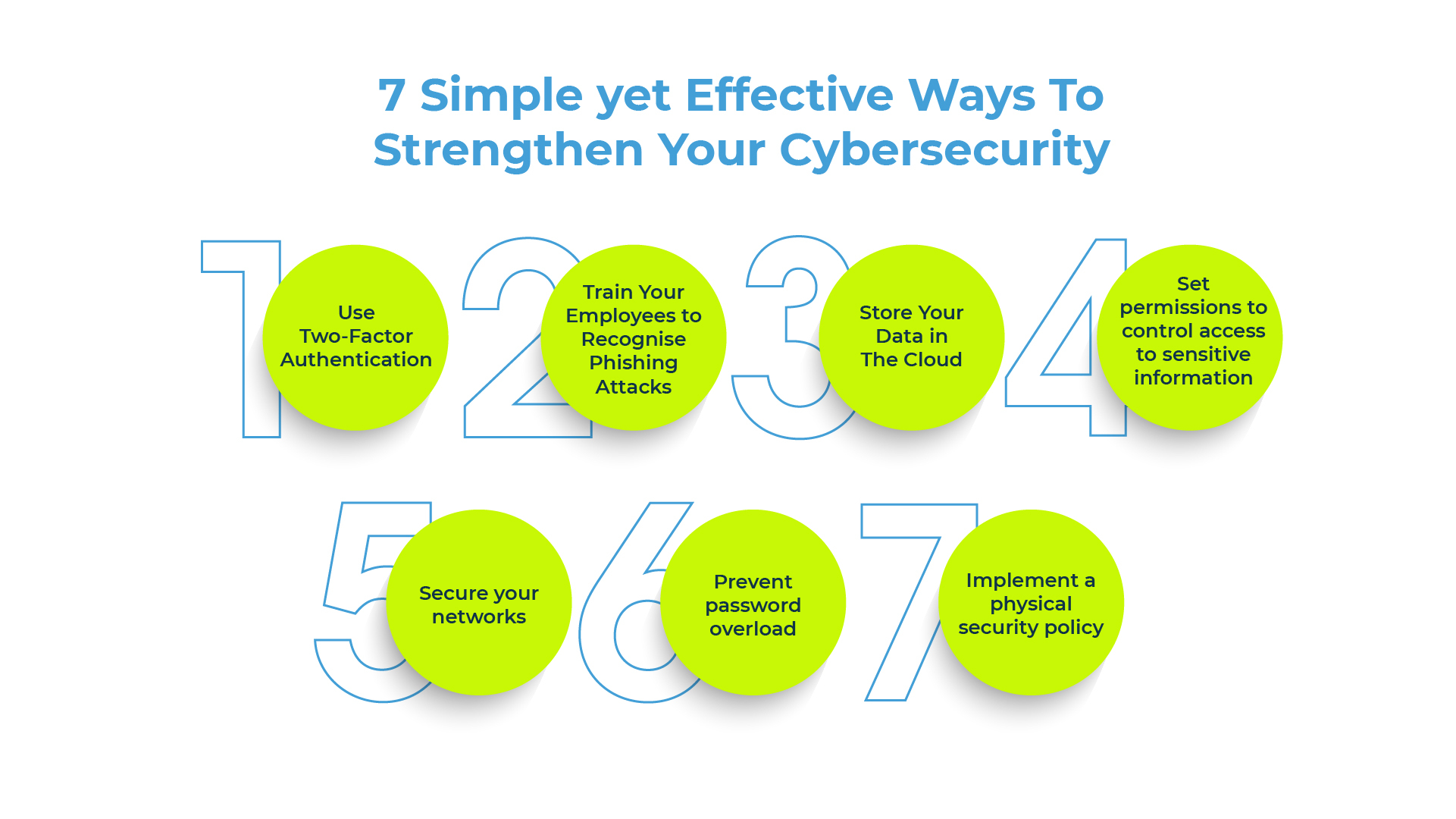
7 Simple yet Effective Ways To Strengthen Your Cybersecurity
By Chris Morino
Cybercrime is evolving, and so is cybersecurity. While no organization is 100% safe from cyber threats, keeping up to date with technology, enforcing high-security practices, and properly training your staff can all help keep your business safe online.
Cybersecurity services are designed to protect your devices, networks, data, and most importantly, your people from outsiders. Many business leaders have said, “that won’t happen to me,” until it eventually did. You’ll want to support your IT department and encourage your staff to observe cybersecurity rules and best practices. Ensure that you invest in technology to avoid becoming a victim of cybercrime in the first place.
Here are our top 7 tips that’ll help strengthen your cybersecurity posture and protect your business by minimizing the potential impact of threats targeting your employees.
1. Use Two-Factor Authentication
Two-factor authentication (2FA) and multi-factor authentication (MFA) are technical terms used to describe how users need to confirm their claimed identity before they are granted access to the company’s network and applications. Users may verify their identity via SMS, e-mail, a mobile authenticator application, or a physical USB security key.
2. Train Your Employees to Recognise Phishing Attacks
On average, 36% of breaches involve phishing—people click on unsolicited links, giving unauthorized users access to company information and systems. By attending phishing training courses, your employees will learn to recognize phishing attacks and understand the need for extra data security measures.
These forms of training should be conducted regularly to keep everyone up to date with new trends and guidelines.
3. Store Your Data in The Cloud
Instead of using local servers and managing data storage in-house, use cloud-based storage for increased efficiency and extra layers of security.
Cloud storage enables you to access information anywhere and with any device—which is essential in hybrid workspaces, where employees need to access company systems from multiple locations. Furthermore, cloud service providers employ numerous layers of cybersecurity to protect your data and defend your files from unauthorized users.
4. Set permissions to control access to sensitive information
When it comes to access management, more isn't always better. The majority of your employees should have limited access to business data—each team member should only have access to the information they require to perform their duties.
Monitor user accounts to quickly identify any abnormal activity. Additionally, establish clear policies on collecting, processing, and storing confidential information. This way, everyone understands what they need to do to safeguard themselves and the business.
5. Secure your networks
If you want to create a hybrid workplace, make it easy for your workers to work from anywhere, including coffee shops and other public spaces. Access to public Wi-Fi networks should be restricted on company devices that connect to your network. Therefore mobile hotspots and/or VPN connections are required so that your employees don't have to use public Wi-Fi.
Providing a guest network for visitors, personal devices, and other non-company secure-verified devices is another option to protect your network.
6. Prevent password overload
While strong passwords help increase security, managing multiple complex passwords can become difficult. Everyone is urged not to share, write down, or re-use passwords, which can quickly become an issue for individuals who must handle many passwords for work—59 percent of IT professionals admit that their organizations rely on memory for this task.
Providing password management software and making it simple for people to change their passwords are two of the finest methods to support employees. When users need to change their passwords, the password manager will automatically update them. Furthermore, by using 2FA or MFA, you may rotate passwords less frequently, easing the burden on your personnel.
7. Implement a physical security policy
In offices, physical security is equally as vital as cybersecurity. Simple precautions, such as not writing passwords on post-it notes and locking a computer before leaving it unattended, can give an extra layer of protection.
End-users need clear policies and reinforced staff education to stay on top of their duties. Automating computer locks and encouraging employees to adopt password management software can help relieve users of responsibility, ensuring that policies are followed.
Conclusion
Cybersecurity is a vast field, and new methods to protect your devices, data, and people constantly emerge to keep up with cyber threats. By taking the necessary safeguards, your organization can minimize its online risk.
Perform periodic assessments, update any out-of-date policies, and ensure that your staff receives current training to foster a culture around cybersecurity.
A sound cybersecurity policy requires multiple layers of technology and best practices, and additional cybersecurity solutions are necessary to secure your network and devices against a broader range of cyberattacks. To discover more about the tools and approaches that can help you safeguard your company online, see our blog post Understanding Cybersecurity Solutions.



